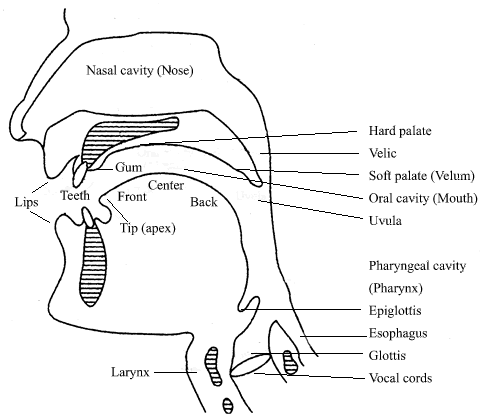2.2 The sound-producing mechanism
Speech sounds are produced by various speech organs. Understanding the
production of speech sounds requires some knowledge of the sound-producing
system (See the figure below). Sounds are produced when air is set in
motion. The lungs produce the air stream. As the air stream flows out,
it may be modified by the speech organs, and a variety of sounds are thus
produced. The sound source is the larynx,
inside which two fine sheets of muscle called the vocal
cords (folds) are located across the end of the trachea (windpipe).
The vocal cords can be pulled apart or drawn closer together to control
the air stream. The opening between the vocal cords is called the glottis.
Different states of the glottis controlled by the vocal cords determine
whether sounds are voiced or voiceless. All the English and Chinese speech
sounds are produced with the air stream pushed out of the glottis, thus
called egressive sounds.
Some speech sounds in some languages are produced with the air sucked
in instead of flowing out, these sounds are called ingressive
sounds.
Out of the glottis, the air stream goes through the pharynx, the area of the throat between the larynx and the uvula. The pharyngeal cavity is about 7 cm long in women and about 8 cm in men. Sounds produced in the pharyngeal cavity are not found in English and Chinese but are found in many dialects of Arabic. Further up, the air stream goes through either the oral cavity or the nasal cavity.
The oral cavity contains most of the articulators, namely, the uvula,
the velum (soft palate), the hard palate, the alveolar ridge, the teeth,
the lips, and the tongue. Among these, only the uvula and the tongue are
flexible. Uvular sounds are produced by raising the back of the tongue
to the uvula. The r in French is
a uvular, symbolized by [R]. There are no uvular sounds in English. The
tongue is the only active articulator in producing English sounds, because
it can be moved to different places in the oral cavity and different parts
of it can be raised. It can block the passage of the air stream out of
the mouth and let it go through the nasal cavity. When [![]() ],
[
],
[![]() ], [
], [![]() ]
are produced in English, the air stream goes out through the nose.
]
are produced in English, the air stream goes out through the nose.
